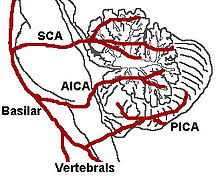Cerebellar stroke syndrome
| Cerebellar stroke syndrome | |
|---|---|
 | |
| The three major arteries of the cerebellum: the SCA, AICA, and PICA | |
| Specialty | Neurology |
Cerebellar stroke syndrome is a condition in which the circulation to the cerebellum is impaired due to a lesion of the superior cerebellar artery, anterior inferior cerebellar artery or the posterior inferior cerebellar artery.[1]
Cardinal signs include

Cerebellar strokes account for only 2-3% of the 600,000 strokes that occur each year in the United States.CT scanning.[4] Advancements have also been made which allow earlier management for common complications of cerebellar stroke such as brainstem compression and hydrocephalus.[4]
Research is still needed in the area of cerebellar stroke management; however, several factors may lead to poor outcomes in individuals who have a cerebellar stroke. These factors include:
- Declining levels of consciousness
- New signs of brainstem involvement
- Progressing Hydrocephalus
- Stroke to the midline of the cerebellum (a.k.a. the vermis) [4]
References
- S2CID 22989987.
- ISBN 978-0521771429.[page needed]
- PMID 11157193.
- ^ PMID 15824250.
Further reading
- Macdonell, R.A.; Kalnins, R.M.; Donnan, G.A. (1987). "Cerebellar infarction: Natural history, prognosis, and pathology". PMID 3629642.
- Edlow, J.A.; Newman-Toker, D.E.; Savitz, S.I. (2008). "Diagnosis and initial management of cerebellar infarction". S2CID 25118582.
- Norrving, Bo (2014). Oxford Textbook of Stroke and Cerebrovascular Disease. ISBN 9780199641208.
- Nowe, Tim; Jütter, Eric (2014). "Ch. 17: Critical Care of Cerebellar Stroke". In Schwab, Stefan; Hanley, Daniel; Mendelow, A. David (eds.). Critical Care of the Stroke Patient. ISBN 9780521762564.
- Manto, Mario Ubaldo (2010). "Ch. 8: Cerebellar Stroke". Cerebellar Disorders: A Practical Approach to Diagnosis and Management. ISBN 9780521878135.
